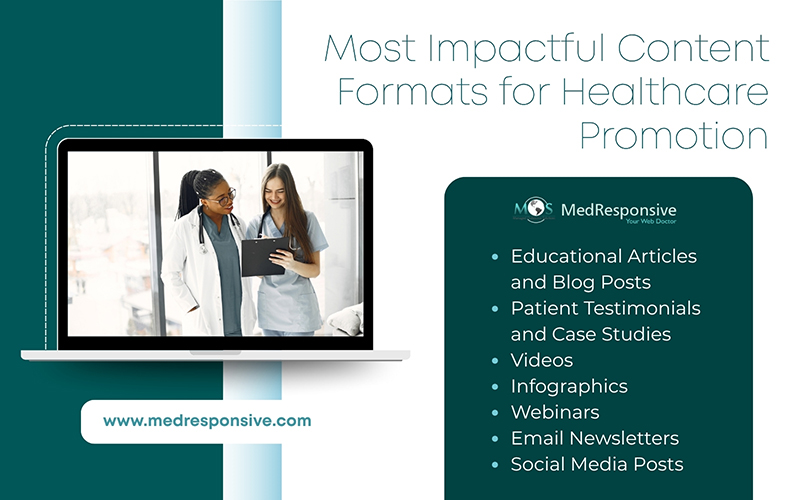Healthcare organizations today need more than just informative content to connect with their audiences effectively. Successful digital marketing requires presenting valuable information in formats that people prefer to receive and engage. While some favor reading articles, others may respond better to short clips or infographics. Choosing the right content format is not optional, but a necessity, as different types serve different purposes. Whether the goal is to educate patients or motivate action, tailoring your content format for healthcare marketing to audience preferences influences how well your message is received, understood, and shared.
For practices, selecting the right format can determine whether your message gets ignored or becomes a valuable touch point in digital marketing for healthcare.

How to Create Effective Healthcare Marketing Content
Crafting healthcare marketing content that truly connects with your audience takes careful planning and thoughtful execution. To stand out and deliver value, your content should be clear, trustworthy, and tailored to patient needs. Below are key principles to guide you in creating effective healthcare marketing materials:
- Understand Your Audience: Research the demographics, concerns, and preferences of your target patients. Content that addresses their specific questions and challenges will be more relevant and engaging.
- Use Storytelling: Incorporate real patient stories, expert interviews, or practical health tips. Storytelling humanizes your brand and makes information more memorable.
- Incorporate Visual Elements: Support your written content with infographics, photos, or videos to improve comprehension, especially for complex topics.
- Ensure Credibility: Reference authoritative sources, highlight qualifications of your medical team, and keep practice’s information current. This builds credibility and strengthens your reputation.
- Analyze and Adapt: Track how your content performs by reviewing KPI metrics and listen to audience feedback. Use this data to refine future topics and strategies implemented, allowing for continuous improvement with each post.
By following these content marketing best practices in healthcare, your website can improve SEO rankings, boost appointment rates, and encourage positive action among your audience.
Best Content Formats for Healthcare Marketing Campaigns
When it comes to healthcare advertising methods, certain content formats consistently perform well:
- Educational Articles and Blog Posts
Written content remains an essential part of building a lasting connection with your audience in healthcare marketing strategies. Publishing well-crafted articles and blog posts on your website provides you the space to explore medical topics in depth, clear up misconceptions, and address common patient concerns. This not only strengthens your authority in the field but also shows your commitment to patient well-being through transparency. Also, steer clear of promotional tone and medical jargon that could confuse readers. Instead, use this platform as an opportunity to educate and inform users about actionable health tips with clarity, and accuracy.
Besides educating readers, your posts can improve search engine rankings when SEO-optimized with thoughtful strategies such as keyword optimization and link building. Routinely updating your site with fresh materials keeps readers connected and encourages them to return for more insights. Once you attract solid organic traffic and climb in search rankings, your website reaches broader demographics, enhancing online presence and attracting new patients.
- Patient Testimonials and Case Studies
Patient testimonials carry significant weight in healthcare marketing as they provide personal stories and authentic experiences that prospective patients can relate to. They are a type of social proof that helps to validate the quality of services or products you provide, influencing patients’ decision-making. Always secure patient consent before sharing their experiences to stay compliant with industry regulations and data privacy laws.
Case studies, on the other hand, provide a deeper dive into individual patient journeys, illustrating the real-life application of your treatments. These narratives demonstrate the hurdles patients faced, the specific solutions provided, and the outcomes achieved by your practice. Case studies shared in the form of video documentaries or detailed written pieces can serve as concrete examples of success, making them even more impactful. These detailed stories can also highlight innovative techniques or technologies your practice uses, setting you apart from competitors. Avoid making false promises or overly polished stories as they come across as insincere, pushing readers away.
- Videos
Videos have grown rapidly as a preferred content format across various users because they are captivating and easy to digest, making them a dominant part of medical content marketing. They help demystify treatments, share facility tours, or highlight new technology introduced in your medical facility. Healthcare providers can also repurpose video clips into ads, reels, or in-app content for maximum ROI across multiple digital channels.
Short, focused videos tend to perform best on social media platforms. Clear narration, professional visuals, and subtitles enhance accessibility and viewer retention. Posting videos on platforms like YouTube or embedding them on your website expands your reach. Effectively utilizing video marketing with BTS clips, interviews, and animations not only widens your audience, but also humanizes your brand, boosting brand recognition.
- Infographics
Infographics condense complex information into visually digestible formats. They are particularly useful for illustrating statistics, timelines, or processes related to health topics. Infographics simplify challenging concepts by combining graphics with brief, clear text. They help patients grasp key concepts, such as explaining the stages of a medical procedure or outlining preventive health measures. Use balanced colors, clear fonts, and a logical flow to make your infographics eye-catching and effective. Sharing these on social media or websites increases the likelihood of content being noticed and shared.
- Webinars
Interactive content formats such as webinars and live Q&A sessions provide an opportunity for real-time interaction. It lets you discuss important topics in depth and answer questions directly from the audience. Webinars are ideal for targeting specific audience demographics through new research findings, preventive care strategies, or chronic disease management. Recording webinars and making them available on demand extends their value. Promoting these events through email and social media ensures better attendance for future events as well.
- Email Newsletters
In a crowded digital space, email campaigns remain a vital channel for delivering private, high-value health content straight to your patients’ inbox. Newsletters allow you to nurture relationships and keep your practice at the top of mind with curated content, updates, and personalized messages. These may include appointment reminders, seasonal wellness tips, or announcements about new services. Personalization goes a long way, so segment your list based on patient interests, age groups, or health concerns to ensure that the content feels relevant.
For instance, parents may appreciate pediatric advice, while older adults might engage more with content on aging or chronic condition management. Including a clear call to action, whether it’s booking an appointment, or reading a new article, drives engagement. Finally, track your open and click-through rates to understand what resonates with your audience, and use those insights to fine-tune your advertising strategy.
- Social Media Posts
Social media healthcare campaigns provide a versatile and dynamic way to reach diverse audiences. Use short posts, images, and videos to raise awareness, share timely info, and build a community around your practice. Different social media platforms serve unique purposes, for instance, Instagram and Facebook are ideal for sharing rich visual stories and patient success highlights, while X is perfect for delivering timely news, and quick announcements.
To maximize impact, maintaining a regular posting schedule and actively engaging with comments and messages helps build trust and strengthen the patient-provider relationship. Additionally, leveraging features like Instagram Stories, Facebook Live, and X polls can enhance interaction and keep the audience invested in your content. Social media also allows for targeted advertising, enabling practices to reach specific demographics and drive patient acquisition effectively.
No single content format suits every healthcare marketing goal. The most effective strategies combine multiple formats tailored to the audience and message. What works for patient education may differ from what drives appointment bookings, which is why understanding the strengths of each format is essential for effective, results-driven marketing. Delegating this responsibility to experienced healthcare digital marketing services not only lightens your team’s workload but also ensures your content strategy is purposeful, consistent, and aligned with long-term growth objectives.




